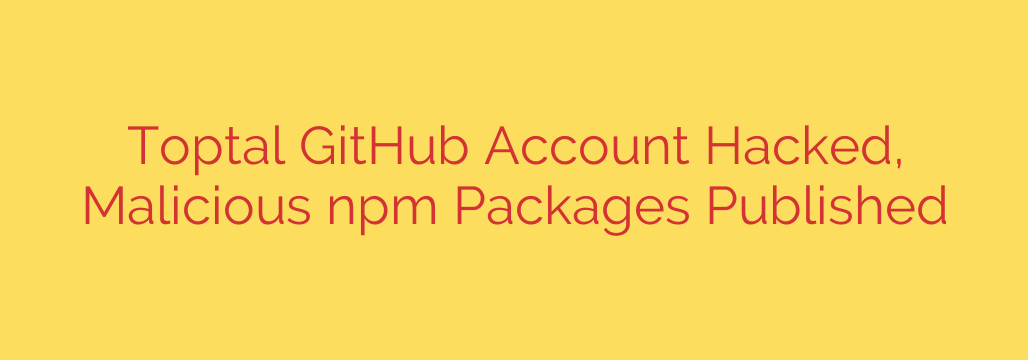
Toptal GitHub Breach: A Wake-Up Call for Developer Account Security
A recent high-profile security breach has once again cast a spotlight on the critical vulnerabilities within the software supply chain. The GitHub organization account for Toptal, a prominent global network of freelance talent, was compromised, leading to the publication of malicious packages on the npm registry. This incident serves as a stark reminder that even well-established companies are prime targets for sophisticated attacks, and developer accounts are the new frontline.
The attack highlights a growing trend where cybercriminals target developers directly to inject malicious code into widely used software ecosystems. Understanding how this breach occurred is the first step toward building a stronger defense.
Anatomy of the Attack: How a Single Token Caused a Cascade
The entire incident hinged on a common but highly potent security oversight: a stolen developer Personal Access Token (PAT). These tokens are powerful credentials that grant programmatic access to GitHub accounts and repositories, often with extensive permissions.
Here’s a breakdown of the attacker’s methodology:
- Credential Compromise: The attacker gained possession of a developer’s PAT, effectively giving them the keys to the Toptal GitHub account.
- Malicious Package Creation: Using this access, the threat actor created and published several malicious packages to the public npm registry. The packages were deceptively named to appear legitimate, using names like
toptal-core,toptal-ui, andtoptal-legacyto trick developers into installing them. - Data Exfiltration: The code hidden within these packages was an info-stealer designed to harvest and exfiltrate sensitive data from any system where it was installed. The malware specifically targeted crucial information, including:
- System details (hostname, directory paths)
- IP address and user information
- Crucially, environment variables and
.envfiles, which often contain API keys, database credentials, and other secrets.
This type of malware is particularly dangerous because it turns a developer’s machine into an entry point for broader attacks on their organization’s infrastructure.
The Broader Threat: Open-Source Supply Chain Attacks
This incident is not an isolated event but part of a disturbing pattern of software supply chain attacks targeting open-source repositories. Platforms like npm, PyPI, and RubyGems are attractive targets because a single malicious package can be downloaded and integrated into thousands of projects, multiplying the attacker’s impact exponentially.
By compromising a trusted developer account or organization, attackers bypass traditional security measures. They leverage the established trust in a brand or project to distribute their malware, a technique far more effective than trying to promote a new, unknown malicious tool.
Actionable Security Measures for Developers and Organizations
The Toptal breach underscores the urgent need for robust security hygiene. Protecting developer accounts and the software supply chain is a shared responsibility. Here are essential, actionable steps every developer and organization must take immediately.
1. Secure Your Personal Access Tokens (PATs)
Your PATs are as sensitive as your passwords. Treat them accordingly.
- Use Fine-Grained Tokens: When creating a PAT, grant it only the minimum permissions required for its specific task. Avoid creating “god-mode” tokens with full repository access.
- Set Expiration Dates: Never create a token that doesn’t expire. Setting a short lifespan (e.g., 30, 60, or 90 days) dramatically reduces the window of opportunity for an attacker if the token is ever compromised.
- Audit Regularly: Periodically review all active tokens in your GitHub settings. Revoke any that are no longer needed or that have overly broad permissions.
2. Harden Your Account and Development Environment
Basic security practices are your most effective defense against account takeovers.
- Enforce Multi-Factor Authentication (MFA): This is non-negotiable. MFA should be enabled for every developer on GitHub, npm, and any other critical service. It is the single most effective way to prevent unauthorized access, even if your password or token is stolen.
- Protect Your Environment Variables: Never commit
.envfiles or other sensitive credentials directly to a repository. Add.envto your.gitignorefile immediately. For team-based projects, use a dedicated secrets management solution like HashiCorp Vault, AWS Secrets Manager, or Doppler. - Scrutinize Dependencies: Before adding a new package to your project, inspect it. Check its download history, publication date, and maintainers. Be wary of packages that are new, have very few downloads, or are typosquatted versions of popular libraries. Use tools like
npm auditto check for known vulnerabilities in your existing dependencies.
3. Implement Organizational Security Policies
For companies, security cannot be an afterthought.
- Principle of Least Privilege: Ensure developers only have access to the repositories and permissions they absolutely need to do their jobs.
- Monitor and Alert: Implement monitoring for suspicious activity, such as a developer account publishing a new public package for the first time or unexpected changes to repository permissions.
- Security Training: Educate your development team about the risks of social engineering, phishing, and the importance of credential security.
The security of the modern software ecosystem depends on the diligence of every developer and organization. As attackers refine their techniques, our defenses must evolve to meet them. By treating developer accounts as critical infrastructure and implementing these robust security measures, we can work to secure the supply chain for everyone.
Source: https://www.bleepingcomputer.com/news/security/hackers-breach-toptal-github-account-publish-malicious-npm-packages/








